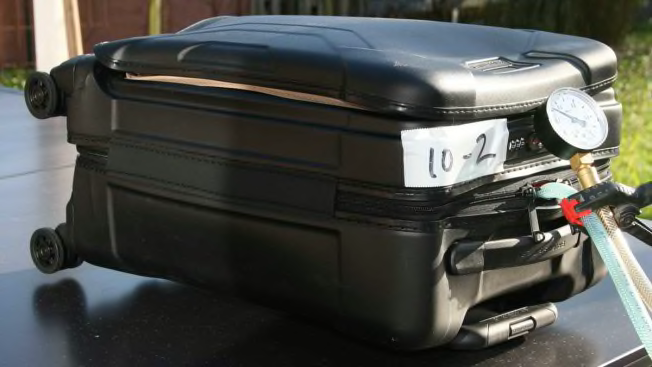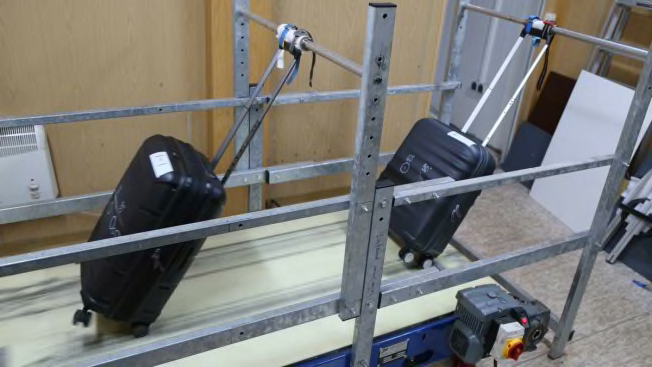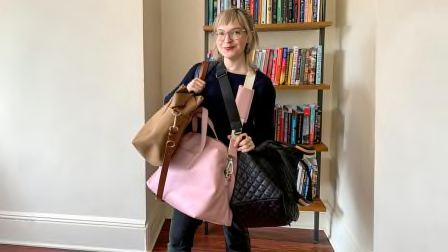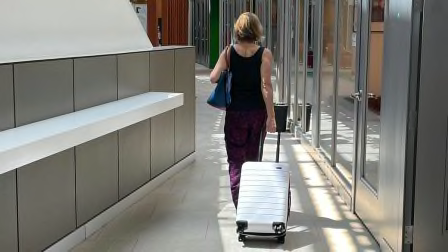Here Are 3 of the Best Hard-Shell Suitcases From Our Tests—Including Picks Under $150
You can spend over $1,000 on a carry-on spinner, but our tests find that high-quality hard-shell bags cost a fraction of that
When you shop through retailer links on our site, we may earn affiliate commissions. 100% of the fees we collect are used to support our nonprofit mission. Learn more.

At Consumer Reports, we’ve rated more than 20 hard-shell carry-ons, ranging in price from under $50 to over $1,000, from brands like Herschel, Rimowa, and Tumi. Our rigorous testing has proven, time and again, that you don’t have to spend a fortune to get a sturdy piece of luggage—in fact, some of the cheapest hard-shell carry-ons we tested perform the best.
Best Hard-Shell Carry-On Luggage
Here are the three highest-performing hard-shell models in our ratings. While most are slightly bigger than the standard 22x14x9 inches requirement for carry-on luggage on U.S. domestic airlines, they should fit in most overhead bins.
Why Choose a Hard-Shell Suitcase?
Hard-shell luggage has grown in popularity, thanks in part to marketing by premium brands such as Away and Rimowa. Typically made of high-tech plastic, the bags are a good option for protecting valuables. Some models expand in the middle like soft-sided luggage, offering added flexibility when you need more space.
As a group, the hard-shell carry-on bags we tested performed capably, with nearly every bag getting a very good Overall Score. However, they differ in how easy they are to open, pack, close, and maneuver, and in how well they withstand our rigorous simulations of the wear and abuse a travel bag must endure.
“You’re going to be pulling the luggage, picking it up, going up and down curbs,” Kollontai says. “You want it to not only serve in its intended use but also survive if it has to be checked—or you have to sit on it during a long layover.”
On the whole, hard-shell luggage is pretty durable. However, the models we tested didn’t score as high as soft-shell cases in our carrying and pulling evaluation. Soft shells also tend to have exterior pockets, which are great for easy access to things you need. Still, you may want to buy hard-shell luggage if you often travel with breakable items like glass. It can also offer better security than soft-sided baggage because it’s somewhat harder to rip open. Soft shells are less likely to have integrated locks in their design, though more manufacturers are adding this feature.
If you’re still unsure which option to go with, read our article on choosing between hard-shell and soft-sided luggage. (And if you’re interested in duffel bags and travel backpacks, we’ve evaluated those, too.)
Meeting Airlines’ Carry-On Requirements
All of the bags in our tests were identified as “carry-ons” by the manufacturer or specified in their names that they’re less than 22 inches tall. But don’t assume that they meet the 22x14x9 inches carry-on dimensions of the strictest U.S. domestic carriers. According to the manufacturers’ listed measurements, not all bags in our ratings fall within that limit.
If you’re traveling internationally, there’s even less room to play with. Make sure your bag is less than 21.7 inches tall, including the stowed handle and wheels.
The soft- and hard-shell suitcases we tested from Away, Briggs & Riley, Calpak, and Herschel are likely to pass muster regardless of the carrier you fly on. Those from Monos and Tumi are aptly sized for domestic carriers. The Amazon Basics models (soft- and hard-shell) come very close to the dimensions allowed by U.S.-based airlines.

Photo: Consumer Reports Photo: Consumer Reports
How CR Tests Hard-Shell Luggage
In Consumer Reports’ tests, we put small, hard-shell carry-on bags from numerous brands through 31 evaluations of usability, impact resistance, carrying and pulling, construction quality, ergonomics and design, and safety.
@consumerreports We really put 12 luggage options through their paces 💪🧳. Read more at cr.org/carryonluggage #traveltiktok #luggage #traveltok #carryon
♬ original sound - Consumer Reports
To gauge durability, we fill each bag with fabric until its total weight is almost 18 pounds, then wheel it along an obstacle-studded conveyor belt for the equivalent of 30-plus miles. A machine lifts those loaded bags by the handle 5,000 times. We drop the bags more than 3 feet onto hard flooring after storing them at summer and winter temperatures, conditions that are potentially tough on hard plastic. We leave the bags, zipped, in a sprinkler-simulated downpour to see what seeps through the zipper fabric. We inflate a large air bladder inside to check how the seams hold up. We load almost 225 pounds on top and to the side to gauge each bag’s resilience, should it end up at the bottom of a cargo pile. And we swing a nasty-looking 17-pound pointed metal hammer twice at each carry-on to see what would happen if, say, the bag accidentally fell from a plane’s overhead compartment onto an armrest.

Photo: Consumer Reports Photo: Consumer Reports
But that’s not all. We also consider usability, or the ease of opening, closing, and loading the luggage, and impact resistance, a bag’s ability to resist damage from being dropped or having something dropped onto it. We put the bags to the test, judging them for how they carry and pull items as well. Our construction quality tests measure the quality and performance of the seams, zippers, straps, and hinges of the bag, as well as its weather resistance, and our ergonomic tests focus on the bag’s lock, repairability, noise, and stability. Finally, our safety tests measure how safe the piece of luggage is when considering sharp edges and pinch points.

































